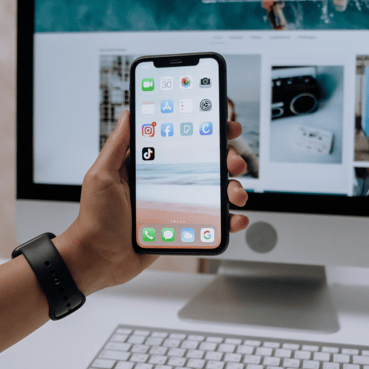If you’re reading this right now, there’s over a 55% chance that you’re doing so on a mobile device. Enhancing your audience’s digital experience by optimizing for mobile elevates their engagement. Responsive design focuses on making sure that your audience can access everything smoothly on their mobile devices. Your website, as well as other platforms, won’t see a lot of success if it’s not optimized for mobile. So make sure all of the buttons, text, images, pages and all other elements are cohesive.
What is Mobile-First Marketing?
Mobile-first marketing prioritizes the mobile experience of your digital content efforts. This encompasses all of the digital, social, and related content channels. You are reaching your audience where they already are, to say the least. Being mobile-centric about your content efforts provides your audience with a more real-time and relevant experience. Not to mention it comes off as more personal when they can reach your site on the devices they use most.
-
Responsive Site
When you think of a website, it’s easy to jump to thinking about the original form that is designed for PC. A responsive website takes design to the next level by making mobile navigation easy. With 67% of mobile users saying they're more likely to invest in a mobile-friendly site, it’s time to optimize your site for mobile. When your website’s design isn’t optimized for mobile, the audience misses out on the elements that make your website worth visiting. Make sure all of the buttons, text, and webpages are laid out to be used through mobile devices. Responsive website design is a great way to encourage multi-channel use through computers and mobile devices.
-
Local Search
 Engaging your local audience heavily relies on a good mobile experience. If people are on the go, they are most likely using a mobile device. That’s why 80% of local mobile searches result in a purchase. Inserting your address into prominent areas on your site like your site footer, meta footer and description provide ways for mobile users to easily discover you by search. It’s also worthwhile to embed a Google Map of your location on a page on your site. Outside of your website, don’t overlook the power of setting up a Google My Business profile to give a strong first impression without hoops to jump through to get your information.
Engaging your local audience heavily relies on a good mobile experience. If people are on the go, they are most likely using a mobile device. That’s why 80% of local mobile searches result in a purchase. Inserting your address into prominent areas on your site like your site footer, meta footer and description provide ways for mobile users to easily discover you by search. It’s also worthwhile to embed a Google Map of your location on a page on your site. Outside of your website, don’t overlook the power of setting up a Google My Business profile to give a strong first impression without hoops to jump through to get your information. -
Pop Ups
The average desktop conversion rate is 9.6%, while mobile popups convert at 11.1%. Pop-ups have the potential to be very successful in your digital efforts, but if they aren’t correctly formatted they can also have an adverse effect on your site’s overall mobile experience. Elements like popups, if not optimized correctly, can cause a disruption in terms of screen space, and also have a big effect on your search ranking. Google recently updated its set of standards regarding pop-ups to ensure these elements don’t drastically change the mobile experience.
The goal behind these guidelines is focused on making sure mobile elements are non-obstructive and easy to close. The exception to these guidelines is mandatory forms like login pages, age verification, and cookie notices - to name a few. It’s important to consider how your site lines up with these guidelines because if it doesn’t you will see an impact on your ranking and click-through rate, especially in terms of mobile. -
Email Marketing
Over 42% of emails are opened via mobile. Only 18% are opened on desktops, and the rest are lost in cyberspace. In order to create the best email experience for mobile, it’s important to consider alternative text (alt text). Alt text displays in place of images when graphics won’t load. If your email header includes an image, it’s best to change the name to something related to the subject of the email. On top of that, creating a clear subject line makes a world of difference when it comes to email optimization.
Everything is done at a faster pace when thinking about mobile. People usually don’t spend large chunks of time on mobile, they just frequently check in with it to stay up to date. So, when mobile users have a few minutes to check their email, they usually think about their inbox in terms of importance. Basically, they subconsciously divide their inbox into three categories: "read, delete, and save for later." When the subject line lacks significance, you're headed straight toward the "delete" category. Developing a subject line that pulls the audience in is the best way to get your email read immediately, or at the least starred for later. -
SMS Marketing

SMS marketing uses text messages to reach an audience with messaging related to their business. Obviously, this method needs to be optimized for mobile, because texts are a channel used primarily with mobile. 45% of people reply to branded text blasts they receive. Now is the best time to start sending texts in order to get a leg up on your competition, because over 60% of businesses still aren’t using SMS marketing in their digital efforts.
-
Social Media
Most social networks are designed for mobile experiences. Instagram has more than 1.4 billion monthly active users. The Instagram experience, along with most other trending social platforms, is reliant on mobile. All content uploading and the most convenient method is done through the mobile app.
-
Apps
 Apps have been a foreign concept to lots of businesses, but the market has developed significantly in the last few years. Apps are now a great tool for any business to implement a better mobile experience and further engage their audience. Mobile apps carry a lot of power. Over 70% of all US digital media time comes from mobile apps. Apps are more interactive because you are using your own interface. Creating an app allows for a more unique experience because it provides benefits a website isn’t capable of providing. Think about how much more effective subscriptions and deals are if you can promote them directly through your own interface and not through a website.An app creates a more personal experience with the audience through push notifications that can be used to share news and promotions, and the unique interface.
Apps have been a foreign concept to lots of businesses, but the market has developed significantly in the last few years. Apps are now a great tool for any business to implement a better mobile experience and further engage their audience. Mobile apps carry a lot of power. Over 70% of all US digital media time comes from mobile apps. Apps are more interactive because you are using your own interface. Creating an app allows for a more unique experience because it provides benefits a website isn’t capable of providing. Think about how much more effective subscriptions and deals are if you can promote them directly through your own interface and not through a website.An app creates a more personal experience with the audience through push notifications that can be used to share news and promotions, and the unique interface.




